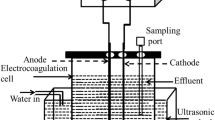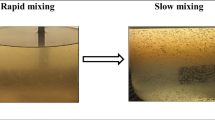Abstract
The effectiveness of the process of ultrasonication (US), electrocoagulation (EC) and hybrid sono-electrocoagulation (US+EC) on landfill leachate wastewater treatment was evaluated based on the removal efficiency of % color and % Chemical Oxygen Demand (COD) along with power consumption. The experimental results showed that the hybrid US+EC had a high color (100%) and COD (94%) removal efficiency with a lower power consumption of 4.50 kWh/m3 compared to the individual EC and US processes. In this hybrid US+EC process, the effects of various operating parameters were investigated and optimized using Design-Expert (12) based on the central composite design approach. The optimization results indicated a maximum COD removal efficiency of 71.05% with a minimum power consumption of 2.33 kWh/m3 at the following optimal experimental conditions: electrolyte concentration (X1) = 0.76 g/L, current density (X2) = 2.75 A/dm2, COD concentration (X3) = 3919.50 mg/L, sonication power (X4) = 100 W and treatment time (X5) = 36.05 min. The synergistic effect was calculated using the US, EC and US+EC process based on the % COD removal efficiency and has a positive effect of 20.51%. The % COD and % color removal efficiency were analyzed using a closed reflux method and UV-VIS spectrophotometer. Thus, the hybrid US+EC process, significantly enhances the efficiency of pollutants removal from landfill leachate wastewater.








Similar content being viewed by others
Data Availability
The datasets analyzed during the study are available from the corresponding author on request.
References
Ahmadi M, Ghanbari F, Madihi-Bidgoli S (2016) Photoperoxi-coagulation using activated carbon fiber cathode as an efficient method for benzotriazole removal from aqueous solutions: modeling, optimization and mechanism. J Photochem Photobiol A Chem 322–323:85–94. https://doi.org/10.1016/j.jphotochem.2016.02.025
Akbal F, Camcidotless S (2011) Copper, chromium and nickel removal from metal plating wastewater by electrocoagulation. Desalination 269(1–3):214–222. https://doi.org/10.1016/j.desal.2010.11.001
Al-Qodah Z, Al-Shannag M (2017) Heavy metal ions removal from wastewater using electrocoagulation processes: a comprehensive review. Sep Sci Technol 52:2649–2676
Al-Qodah Z, Al-Shannag M (2019) On the performance of ree fadicals combined electrocoagulation treatment processes. Sep Purif Rev 48:143–158
Al-Qodah Z, Al-Shannag M, Bani-Melhem K, Assirey E, Yahya MA, Al-Shawabkeh A (2018) Free radical-assisted electrocoagulation processes for wastewater treatment. Environ Chem Lett 16:695–714
Al-Qodah Z, Tawalbeh M, Al-Shannag M, Al-Anber Z, Bani-Melhem K (2020) Combined electrocoagulation processes as a novel approach for enhanced pollutants removal: A state-of-the-art review. Sci Total Environ:744. https://doi.org/10.1016/j.scitotenv.2020.140806
Al-Shannag M, Lafi W, Bani-Melhem K, Gharagheer F, Dhaimat O (2012) Reduction of COD and TSS from paper industries wastewater using electro-coagulation and chemical coagulation. Sep Sci Technol 47(5):700–708. https://doi.org/10.1080/01496395.2011.634474
Asaithambi P (2016) Studies on various operating parameters for the removal of COD from pulp and paper industry using electrocoagulation process. Desalin Water Treat 57(25):11746–11755. https://doi.org/10.1080/19443994.2015.1046149
Asaithambi P, Sajjadi B, Abdul Aziz AR, Wan Daud WMAB (2016) Performance evaluation of hybrid electrocoagulation process parameters for the treatment of distillery industrial effluent. Process Saf Environ Prot 104:406–412. https://doi.org/10.1016/j.psep.2016.09.023
Asaithambi P, Aziz ARA, Sajjadi B, Daud WMABW (2017) Sono assisted electrocoagulation process for the removal of pollutant from pulp and paper industry effluent. Environ Sci Pollut Res 24(6):5168–5178. https://doi.org/10.1007/s11356-016-6909-5
Aziz ARA, Asaithambi P, Daud WMABW (2016) Combination of electrocoagulation with advanced oxidation processes for the treatment of distillery industrial effluent. Process Saf Environ Prot 99:227–235. https://doi.org/10.1016/j.psep.2015.11.010
Bani-Melhem K, Al-Shannag M, Alrousan D, Al-Kofahi S, Al-Qodah Z, Rasool Al-Kilani M (2017) Impact of soluble COD on grey water treatment by electrocoagulation technique. Desalin Water Treat 89:101–110. https://doi.org/10.5004/dwt.2017.21379
Barışçı S, Turkay O (2016) The performance of electrosynthesised ferrate (VI) ion, electrocoagulation and peroxi-electrocoagulation processes for degradation of cholesterol-lowering drug atorvastatin. Desalin Water Treat 57(53):25561–25571. https://doi.org/10.1080/19443994.2016.1151383
Barzegar G, Wu J, Ghanbari F (2019) Enhanced treatment of greywater using electrocoagulation/ozonation: investigation of process parameters. Process Saf Environ Prot 121:125–132. https://doi.org/10.1016/j.psep.2018.10.013
Behin J, Akbari A, Mahmoudi M, Khajeh M (2017) Sodium hypochlorite as an alternative to hydrogen peroxide in Fenton process for industrial scale. Water Res 121:120–128. https://doi.org/10.1016/j.watres.2017.05.015
Deghles A, Kurt U (2016) Treatment of tannery wastewater by a hybrid electrocoagulation/electrodialysis process. Chem Eng Process Process Intensif 104:43–50. https://doi.org/10.1016/j.cep.2016.02.009
Ding J, Jiang M, Zhao G, Wei L, Wang S, Zhao Q (2021) Treatment of leachate concentrate by electrocoagulation coupled with electro-Fenton-like process: Efficacy and mechanism. Sep Purif Technol 255. https://doi.org/10.1016/j.seppur.2020.117668
Dizge N, Akarsu C, Ozay Y, Gulsen HE, Adiguzel SK, Mazmanci MA (2018) Sono-assisted electrocoagulation and cross-flow membrane processes for brewery wastewater treatment. J Water Process Eng 21:52–60. https://doi.org/10.1016/j.jwpe.2017.11.016
Drogui P, Asselin M, Brar SK, Benmoussa H, Blais JF (2008) Electrochemical removal of pollutants from agro-industry wastewaters. Sep Purif Technol 61(3):301–310. https://doi.org/10.1016/j.seppur.2007.10.013
Fajardo AS, Rodrigues RF, Martins RC, Castro LM, Quinta-Ferreira RM (2015) Phenolic wastewaters treatment by electrocoagulation process using Zn anode. Chem Eng J 275:331–341. https://doi.org/10.1016/j.cej.2015.03.116
Flores N, Brillas E, Centellas F, Rodríguez RM, Cabot PL, Garrido JA, Sirés I (2018) Treatment of olive oil mill wastewater by single electrocoagulation with different electrodes and sequential electrocoagulation/electrochemical Fenton-based processes. J Hazard Mater 347:58–66. https://doi.org/10.1016/j.jhazmat.2017.12.059
Ghanbari F, Wu J, Khatebasreh M, Ding D, Lin KYA (2020) Efficient treatment for landfill leachate through sequential electrocoagulation, electrooxidation and PMS/UV/CuFe2O4 process. Sep Purif Technol 242:116828. https://doi.org/10.1016/j.seppur.2020.116828
GilPavas E, Dobrosz-Gómez I, Gómez-García MÁ (2020) Efficient treatment for textile wastewater through sequential electrocoagulation, electrochemical oxidation and adsorption processes: optimization and toxicity assessment. J Electroanal Chem 878:114578. https://doi.org/10.1016/j.jelechem.2020.114578
He CC, Hu CY, Lo SL (2016) Evaluation of sono-electrocoagulation for the removal of reactive blue 19 passive film removed by ultrasound. Sep Purif Technol 165:107–113. https://doi.org/10.1016/j.seppur.2016.03.047
He CC, Hu CY, Lo SL (2018) Integrating chloride addition and ultrasonic processing with electrocoagulation to remove passivation layers and enhance phosphate removal. Sep Purif Technol 201:148–155. https://doi.org/10.1016/j.seppur.2018.03.011
Kalyani KSP, Balasubramanian N, Srinivasakannan C (2009) Decolorization and COD reduction of paper industrial effluent using electro-coagulation. Chem Eng J 151(1–3):97–104. https://doi.org/10.1016/j.cej.2009.01.050
Katsumata H, Kobayashi T, Kaneco S, Suzuki T, Ohta K (2011) Degradation of linuron by ultrasound combined with photo-Fenton treatment. Chem Eng J 166(2):468–473. https://doi.org/10.1016/j.cej.2010.10.073
Khataee AR, Zarei M, Khataee AR (2011) Electrochemical treatment of dye solution by oxalate catalyzed photoelectro-Fenton process using a carbon nanotube-PTFE cathode: optimization by central composite design. Clean Soil Air Water 39(5):482–490. https://doi.org/10.1002/clen.201000120
Kobya M, Hiz H, Senturk E, Aydiner C, Demirbas E (2006a) Treatment of potato chips manufacturing wastewater by electrocoagulation. Desalination 190(1–3):201–211. https://doi.org/10.1016/j.desal.2005.10.006
Kobya M, Senturk E, Bayramoglu M (2006b) Treatment of poultry slaughterhouse wastewaters by electrocoagulation. J Hazard Mater 133(1–3):172–176. https://doi.org/10.1016/j.jhazmat.2005.10.007
Kobya M, Soltani RDC, Omwene PI, Khataee A (2020) A review on decontamination of arsenic-contained water by electrocoagulation: reactor configurations and operating cost along with removal mechanisms. Environ Technol Innov 17:100519. https://doi.org/10.1016/j.eti.2019.100519
Kovatcheva VK, Parlapanski MD (1999) Sono-electrocoagulation of iron hydroxides. Colloids Surf A Physicochem Eng Asp 149(1–3):603–608
Maha Lakshmi P, Sivashanmugam P (2013) Treatment of oil tanning effluent by electrocoagulation: influence of ultrasound and hybrid electrode on COD removal. Sep Purif Technol 116:378–384. https://doi.org/10.1016/j.seppur.2013.05.026
Monteagudo JM, Durán A, Martín IS, García S (2014) Ultrasound-assisted homogeneous photocatalytic degradation of reactive blue 4 in aqueous solution. Appl Catal B Environ 152–153:59–67. https://doi.org/10.1016/j.apcatb.2014.01.014
Mu Y, Zheng XJ, Yu HQ (2009) Determining optimum conditions for hydrogen production from glucose by an anaerobic culture using response surface methodology (RSM). Int J Hydrog Energy 34(19):7959–7963. https://doi.org/10.1016/j.ijhydene.2009.07.093
Nasrullah M, Singh L, Krishnan S, Sakinah M, Zularisam AW (2018) Electrode design for electrochemical cell to treat palm oil mill effluent by electrocoagulation process. Environ Technol Innov 9:323–341. https://doi.org/10.1016/j.eti.2017.10.001
Nikravesh B, Shomalnasab A, Nayyer A, Aghababaei N, Zarebi R, Ghanbari F (2020) UV/chlorine process for dye degradation in aqueous solution: mechanism, affecting factors and toxicity evaluation for textile wastewater. J Environ Chem Eng 8(5):104244. https://doi.org/10.1016/j.jece.2020.104244
Othmani A, Kesraoui A, Seffen M (2017) The alternating and direct current effect on the elimination of cationic and anionic dye from aqueous solutions by electrocoagulation and coagulation flocculation. Euro Mediterr J Environ Integr 2(1). https://doi.org/10.1007/s41207-017-0016-y
Radi MA, Nasirizadeh N, Rohani-Moghadam M, Dehghani M (2015) The comparison of sonochemistry, electrochemistry and sonoelectrochemistry techniques on decolorization of C.I reactive blue 49. Ultrason Sonochem 27:609–615. https://doi.org/10.1016/j.ultsonch.2015.04.021
Radi MA, Nasirizadeh N, Mirjalili M, Rohani Moghadam M (2019) Ultrasound-assisted electrochemical decolorization of anthraquinone dye C.I reactive blue 49, its optimization and synergic effect: a comparative study. Int J Environ Sci Technol 16(5):2455–2464. https://doi.org/10.1007/s13762-017-1638-y
Raschitor A, Fernandez CM, Cretescu I, Rodrigo MA, Cañizares P (2014) Sono-electrocoagulation of wastewater polluted with Rhodamine 6G. Sep Purif Technol 135:110–116. https://doi.org/10.1016/j.seppur.2014.08.003
Raschitor A, Llanos J, Cañizares P, Rodrigo MA (2020) Improved electrolysis of colloid-polluted wastes using ultrasounds and electrocoagulation. Sep Purif Technol 231. https://doi.org/10.1016/j.seppur.2019.115926
Ren YZ, Wu ZL, Franke M, Braeutigam P, Ondruschka B, Comeskey DJ, King PM (2013) Sonoelectrochemical degradation of phenol in aqueous solutions. Ultrason Sonochem 20(2):715–721. https://doi.org/10.1016/j.ultsonch.2012.09.004
Ren YZ, Franke M, Anschuetz F, Ondruschka B, Ignaszak A, Braeutigam P (2014) Sonoelectrochemical degradation of triclosan in water. Ultrason Sonochem 21(6):2020–2025
Rivera M, Pazos M, Sanromán MA (2009) Improvement of dye electrochemical treatment by combination with ultrasound technique. J Chem Technol Biotechnol 84(8):1118–1124. https://doi.org/10.1002/jctb.2141
Samarghandi MR, Dargahi A, Shabanloo A, Nasab HZ, Vaziri Y, Ansari A (2020) Electrochemical degradation of methylene blue dye using a graphite doped PbO2 anode: optimization of operational parameters, degradation pathway and improving the biodegradability of textile wastewater. Arab J Chem 13(8):6847–6864. https://doi.org/10.1016/j.arabjc.2020.06.038
Song YL, Li JT, Chen H (2009) Degradation of C.I. acid red 88 aqueous solution by combination of Fenton’s reagent and ultrasound irradiation. J Chem Technol Biotechnol 84(4):578–583. https://doi.org/10.1002/jctb.2083
Tezcan Un U, Koparal AS, Bakir Ogutveren U (2009) Electrocoagulation of vegetable oil refinery wastewater using aluminum electrodes. J Environ Manag 90(1):428–433. https://doi.org/10.1016/j.jenvman.2007.11.007
Tran N, Drogui P, Brar SK, De Coninck A (2017) Synergistic effects of ultrasounds in the sonoelectrochemical oxidation of pharmaceutical carbamazepine pollutant. Ultrason Sonochem 34:380–388. https://doi.org/10.1016/j.ultsonch.2016.06.014
Valero D, Ortiz JM, García V, Expósito E, Montiel V, Aldaz A (2011) Electrocoagulation of wastewater from almond industry. Chemosphere 84(9):1290–1295. https://doi.org/10.1016/j.chemosphere.2011.05.032
Vasudevan S, Kannan BS, Lakshmi J, Mohanraj S, Sozhan G (2011) Effects of alternating and direct current in electrocoagulation process on the removal of fluoride from water. J Chem Technol Biotechnol 86(3):428–436. https://doi.org/10.1002/jctb.2534
Veli S, Öztürk T, Dimoglo A (2008) Treatment of municipal solid wastes leachate by means of chemical- and electro-coagulation. Sep Purif Technol 61(1):82–88. https://doi.org/10.1016/j.seppur.2007.09.026
Verma A, Kaur Hura A, Dixit D (2015) Sequential photo-Fenton and sono-photo-Fenton degradation studies of reactive black 5 (RB5). Desalin Water Treat 56(3):677–683. https://doi.org/10.1080/19443994.2014.940390
Wang CT, Chou WL, Kuo YM (2009) Removal of COD from laundry wastewater by electrocoagulation/electroflotation. J Hazard Mater 164(1):81–86. https://doi.org/10.1016/j.jhazmat.2008.07.122
Funding
This research did not receive any specific grant from funding agencies in the public, commercial, or not-for-profit sectors.
Author information
Authors and Affiliations
Contributions
Perumal Asaithambi: Investigation; Data curation; Resources; Writing - original draft. Rajendran Govindarajan: Conceptualization; Methodology; Formal analysis; Validation; Supervision.
Corresponding authors
Ethics declarations
Conflict of Interest
The authors declare that they have no conflict of interest.
Additional information
Publisher’s Note
Springer Nature remains neutral with regard to jurisdictional claims in published maps and institutional affiliations.
Rights and permissions
About this article
Cite this article
Asaithambi, P., Govindarajan, R. Hybrid Sono-Electrocoagulation Process for the Treatment of Landfill Leachate Wastewater: Optimization through a Central Composite Design Approach. Environ. Process. 8, 793–816 (2021). https://doi.org/10.1007/s40710-021-00509-z
Received:
Accepted:
Published:
Issue Date:
DOI: https://doi.org/10.1007/s40710-021-00509-z




